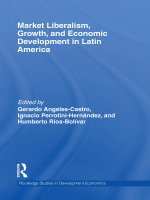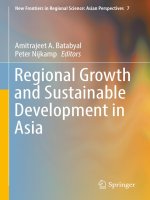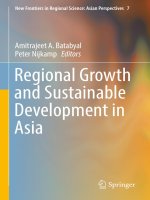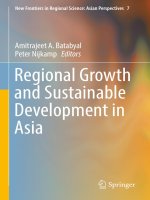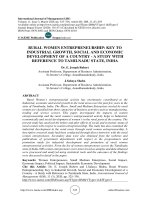Economic growth and economic development 49
Bạn đang xem bản rút gọn của tài liệu. Xem và tải ngay bản đầy đủ của tài liệu tại đây (44.3 KB, 1 trang )
Introduction to Modern Economic Growth
schooling; if this is the case, these omitted factors may be removed when we look at
changes. While we cannot reach a firm conclusion on these alternative explanations,
the strong correlation between the level of average schooling and economic growth
documented in Figure 1.17 is interesting in itself.
The narrowing of income per capita differences in the world economy when
countries are weighted by population is explored in Sala-i-Martin (2005). Deaton
(2005) contains a critique of Sala-i-Martin’s approach. The point that incomes
must have been relatively equal around 1800 or before, because there is a lower
bound on real incomes necessary for the survival of an individual, was first made
by Maddison (1992) and Pritchett (1996). Maddison’s estimates of GDP per capita
and Acemoglu, Johnson and Robinson’s estimates based on urbanization confirm
this conclusion.
The estimates of the density of income per capita reported above are similar
to those used by Quah (1994, 1995) and Jones (1996). These estimates use a nonparametric Gaussian kernel. The specific details of the kernel estimates do not
change the general shape of the densities. Quah was also the first to emphasize
the stratification in the world income distribution and the possible shift towards a
“bi-modal” distribution, which is visible in Figure 1.3. He dubbed this the “Twin
Peaks” phenomenon (see also Durlauf and Quah, 1994). Barro (1991) and Barro
and Sala-i-Martin (1992) emphasize the presence and importance of conditional convergence, and argue against the relevance of the stratification pattern emphasized
by Quah and others. The first chapter of Barro and Sala-i-Martin’s (2004) textbook
contains a detailed discussion from this viewpoint.
The first economist to emphasize the importance of conditional convergence and
conduct a cross-country study of convergence was Baumol (1986), but he was using
lower quality data than the Summers-Heston data. This also made him conduct his
empirical analysis on a selected sample of countries, potentially biasing his results
(see De Long, 1991). Barro’s (1991) and Barro and Sala-i-Martin’s (1992) work using
the Summers-Heston data has been instrumental in generating renewed interest in
cross-country growth regressions.
The data on GDP growth and black real wages in South Africa are from Wilson
(1972). Feinstein (2004) provides an excellent economic history of South Africa.
35
